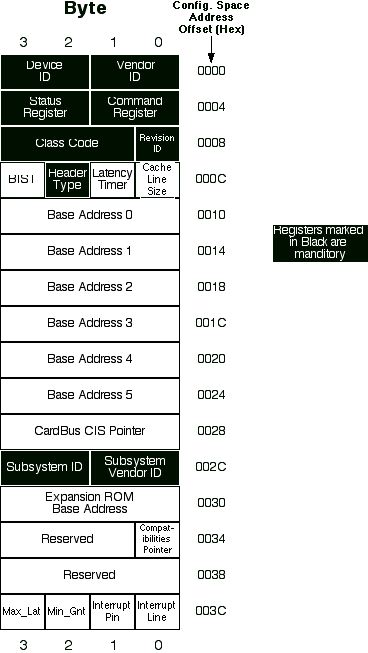
The PCI configuration header
#include <pci.h>
Data Fields | |
| uint16_t | vendor_id |
| The vendor ID of this device. | |
| uint16_t | device_id |
| The device ID of this device. | |
| uint16_t | command |
| By writing to this field the system controls the device. | |
| uint16_t | status |
| This field gives the status of the device with the meaning of the bits of this field set by the standard. | |
| uint8_t | revision_id |
| The revision ID of this device. | |
| uint8_t | interface |
| The interface code of this device. | |
| uint8_t | sub_class |
| The sub-class ID of this device. | |
| uint8_t | base_class |
| The base-class code of this device. | |
| uint8_t | cache_line_size |
| The cache line size. | |
| uint8_t | latency_timer |
| The latency timer. | |
| uint8_t | header_type |
| The header type. | |
| uint8_t | bist |
| Build-in Self Test. If BIST is implemented, can write to a 1 to initiate BIST. | |
| uint8_t | bus |
| The bus number where this device resides. | |
| uint8_t | dev |
| The device number where this device resides. | |
| uint8_t | func |
| The function number where this device resides. | |
| uint8_t | irq |
| The IRQ line (if the device has it! otherwise it is 0). Remeber that a PCI IRQ line can be shared between more than one device. This is a fetature of the PCI devices only. If more than one device shares a IRQ line the software must provide an opportune interrupt handler that recognizes the right device which causes the interrupt and switches the execution between the dedicated routines. | |
| uint32_t | base [6] |
| Base addresses (for both I/O and memory-based devices). Every PCI device has up to 6 base addresses (6 for normal devices, 2 for PCI to PCI bridges and only 1 for cardbuses). | |
| uint32_t | size [6] |
| Size of the I/O space. For memory-based devices it is the size of the memory-mapped buffer; for I/O based devices it is the maximum offset of the ports used. | |
| uint8_t | type [6] |
| Type of the I/O operation (memory based or I/O based). | |
| uint32_t | rom_base |
| The ROM base address. | |
| uint32_t | rom_size |
| The ROM memory space. | |
| uint16_t | subsys_vendor |
| Subsystem vendor ID. | |
| uint16_t | subsys_device |
| Subsystem device ID. | |
| uint8_t | current_state |
| Power management state (from D0 to D3). | |

The PCI configuration header
Definition at line 173 of file pci.h.
|
|
Base addresses (for both I/O and memory-based devices). Every PCI device has up to 6 base addresses (6 for normal devices, 2 for PCI to PCI bridges and only 1 for cardbuses).
|
|
|
The base-class code of this device.
|
|
|
Build-in Self Test. If BIST is implemented, can write to a 1 to initiate BIST.
|
|
|
The bus number where this device resides.
|
|
|
The cache line size.
|
|
|
By writing to this field the system controls the device.
|
|
|
Power management state (from D0 to D3).
|
|
|
The device number where this device resides.
|
|
|
The device ID of this device.
|
|
|
The function number where this device resides.
|
|
|
The header type.
|
|
|
The interface code of this device.
|
|
|
The IRQ line (if the device has it! otherwise it is 0). Remeber that a PCI IRQ line can be shared between more than one device. This is a fetature of the PCI devices only. If more than one device shares a IRQ line the software must provide an opportune interrupt handler that recognizes the right device which causes the interrupt and switches the execution between the dedicated routines.
|
|
|
The latency timer.
|
|
|
The revision ID of this device.
|
|
|
The ROM base address.
|
|
|
The ROM memory space.
|
|
|
Size of the I/O space. For memory-based devices it is the size of the memory-mapped buffer; for I/O based devices it is the maximum offset of the ports used.
|
|
|
This field gives the status of the device with the meaning of the bits of this field set by the standard.
|
|
|
The sub-class ID of this device.
|
|
|
Subsystem device ID.
|
|
|
Subsystem vendor ID.
|
|
|
Type of the I/O operation (memory based or I/O based).
|
|
|
The vendor ID of this device.
|
 1.2.18
1.2.18